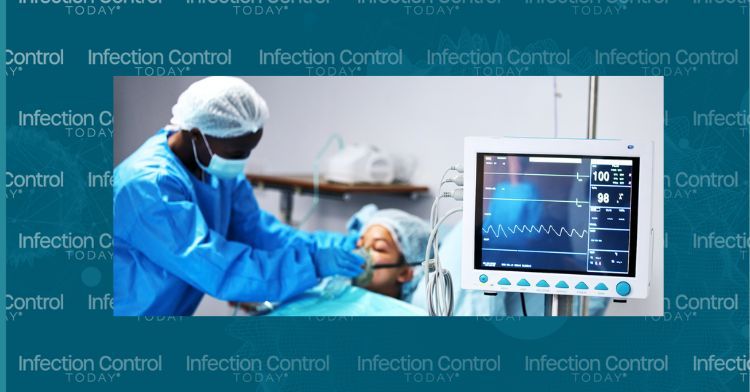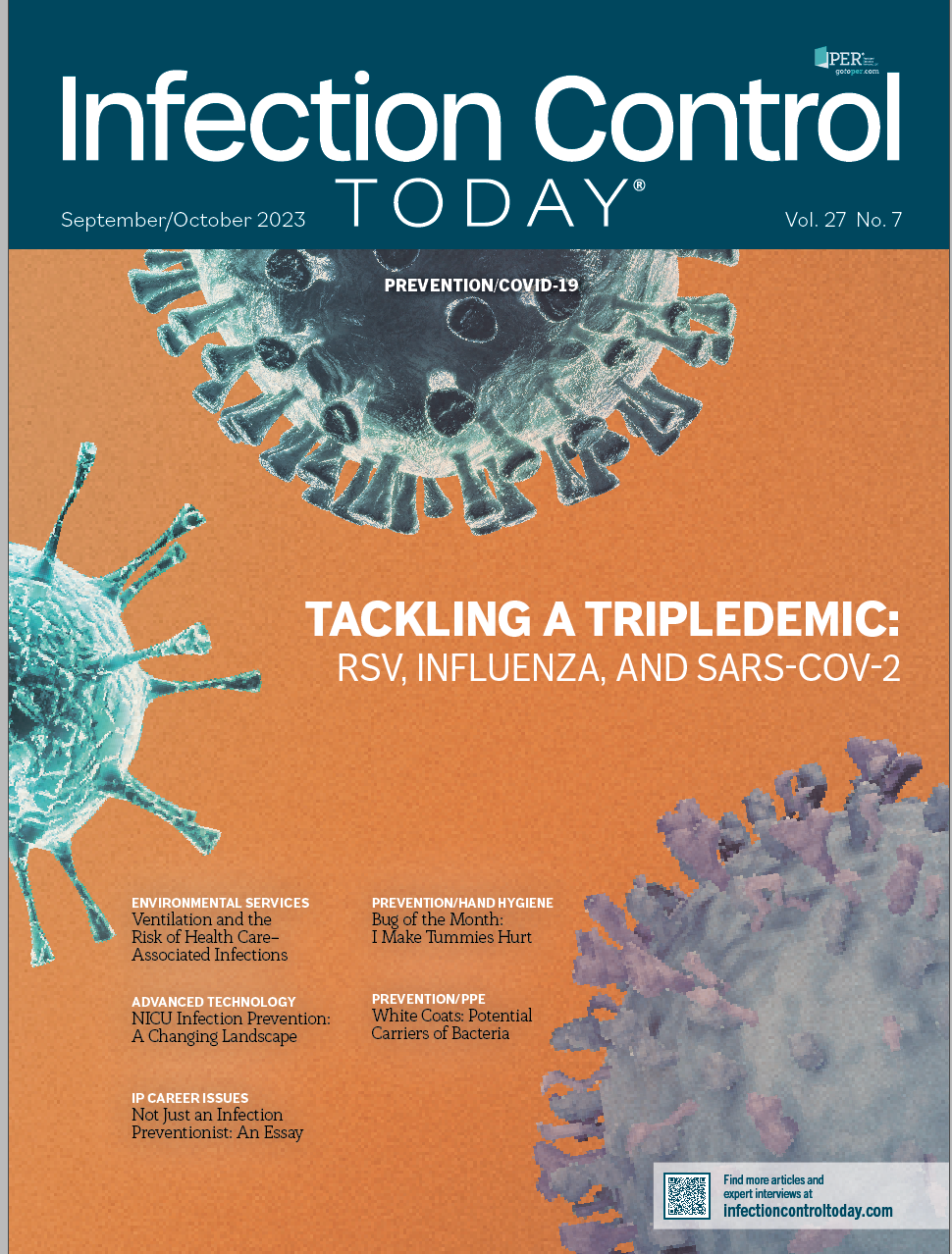Ventilation and the Risk of Health Care–Associated Infections
Heating, ventilation, and air conditioning (HVAC) systems are vital for maintaining air quality in health care facilities. They play a crucial role in reducing disease transmission by regulating air quality. Proper HVAC systems decrease risk through ventilation, filtration, and airflow control.
Health care workers taking care of patient with ventilator
(AdobeStock 620931560 by JoshuAA/peopleimages.com)

Heating, ventilation, and air conditioning (HVAC) systems are essential to air quality and comfort in health care facilities. Air handling systems are also key to reducing risk of disease transmission by diluting or removing contaminated air inside buildings. HVAC systems work to decrease risk through the principles of ventilation, filtration, and flow. Disruptions or inadequate HVAC systems can increase risk of pathogen transmission through the air.
Airborne transmission occurs when pathogens travel on dust particles or aerosolized respiratory droplets. In this method, pathogens can travel long distances on air currents. Examples typically spread via airborne transmission include measles virus, varicella-zoster virus, and tuberculosis. Other respiratory illnesses, including COVID-19, pertussis, and influenza virus, have been shown to travel on respiratory droplets; however, the distance traveled on air currents may be shorter.
When developing risk mitigation, different levels of controls can be employed. Initially, hazard elimination is most effective. Engineering controls can be used to manipulate the built environment. HVAC systems are part of engineering controls for reducing airborne transmission and exposure risk. Administrative controls include policies and protocols that should be based on current evidence. Human-centered tactics, such as personal protective equipment, would be the last level of control.
Numerous studies have described the impact of ventilation during the COVID-19 pandemic. A systematic review in 2022 examined the role of HVAC in COVID-19 transmission.1 Overall, the 20 studies found a decreased risk of infection when ventilation was increased or airflow directed contaminated air away from at-risk individuals.
Another study looked at the impact of ventilation on a tuberculosis outbreak at a university in Taiwan.2 The outbreak resulted after a student with the symptomatic index case attended a class for roughly a month in a room with poor ventilation. Subsequently, 27 cases were identified in the outbreak investigation. The university updated the classroom ventilation system, improved airflow, and measured indoor carbon dioxide (CO2) levels as an indicator of air quality. No new secondary cases were identified as the CO2 levels decreased, indicating improved ventilation.
Regulatory and professional organizations have published guidelines on how HVAC systems are expected to function in health care facilities. Infection preventionists (IPs) must be familiar with these guidelines, including those from the Facility Guidelines Institute (FGI); American Institute of Architects; and American Society of Heating, Refrigerating, and Air-Conditioning Engineers, as well as which version is required based on local or state health department requirements.
Key principles for IPs to understand regarding ventilation and disease prevention include quantity (air changes per hour [ACH]); quality (the filtration and contamination level of air, temperature, and humidity); and flow (pressure differentials as determined by the amount of air supplied vs removed and directionality).
Quantity affects disease transmission by removing contaminated air from a space. As the number of air changes increases, so does particle removal efficiency. For more critical areas, such as operating rooms, minimal ACH is higher than in public or other patient care areas for more critical sites, such as operating, decontamination, or airborne isolation rooms. Therefore, increasing the ACH would decrease risk of transmission. However, there may not be the same effect for close-range contact, so that other mitigation factors, such as masks and respirators, would be needed.
Air quality can be affected by outside air and contamination occurring inside the building. Outside air enters through leaks in windows and doors or through filtration system malfunctions. Additionally, construction near critical areas or intake vents could introduce mold and other particles to indoor air if not properly filtered. It is important to understand how outside air quality can affect indoor air quality. Consider any exterior factors affecting quality, such as wildfires, pollution, or industrial accidents. The ventilation of a facility may need to be adjusted in such circumstances to decrease outdoor intake or increase filtration, which would then affect interior quality.
Despite the impact outdoor air quality can have on indoor settings, many studies recommend having as much outdoor air as possible as part of the intake for an HVAC system as opposed to mixed air, which also includes recirculated air.3 This may be a reasonable consideration for some HVAC systems where the ability to remove internal contaminants is limited because return air filters do not typically have the same processes to remove contaminants that the intake does.
Heating and cooling coils are a key part of typical air handler units (AHU). These coils work by having a hot or cold media in the coils that air passes through, which either removes heat from the air (cooling) or adds warmth (heating). Cooling coils can produce moisture when removing heat from the air. This condensate can be a source of microorganism growth, which can affect air quality and be a source of contamination. The general humidity levels of the air can affect disease transmission in other ways. For example, lower humidity can increase the ability of aerosolized particles to travel further and stay suspended.3
Filtration is installed in HVAC systems to remove contaminants and improve air quality. Filters are designed in the system to catch particles from outside or return air. High-efficiency particulate air (HEPA) filters are used in health care. Typically, an HVAC system will have 2 banks of filters: prefilters and the final filters, usually at the end of the AHU as the air moves into supply. The minimum efficiency reporting value (MERV) is a way of testing filters to determine the ability to collect particles. The MERV scale ranges from 1 to 16, with 16 being the most efficient at removing the smallest particles. Guidelines recommend a minimum of MERV-13, which can remove particles 3.0 to 10.0 µm.3 As a comparison, HEPA filters can remove particles down to 0.3 µm.4 Therefore, in health care settings, HEPA filters are preferred when possible and wherever there would be a clinical advantage from increased filtration capabilities.
As evidenced during the COVID-19 pandemic response, portable HEPA filters or negative pressure machines can be a helpful tool when used to complement existing HVAC systems. This is a common occurrence during construction as well. During construction, if an AHU needs to be shut down, the IP needs to complete a risk assessment with the multidisciplinary construction team and determine what mitigation can take place to remove any risk associated with the transmission of pathogens associated with HVAC. If portable units are being used, it is important to ensure maintenance of the units is performed and documented based on the manufacturer’s instructions for use and regulatory compliance.
Innovations in HVAC decontamination have been introduced in recent years. UV radiation is effective at inactivating pathogens, specifically at the wavelength of 253.7 nm, or UV-C.5 UV radiation has 2 main applications in health care buildings: open-air and in-duct systems. Open-air systems require attention to the risk associated with human exposure. They are recommended for use when no persons are present or in a way where direct exposure to humans does not occur. In-duct systems can decrease the risk of human exposure but can be challenging to install in existing HVAC systems. Ideally, in-duct would be used when contaminated air is exhausted, or there is no way to prevent air recirculation.5 Biofiltration technology is an intriguing innovation in which plant life and microalgae filter air. Practical use in health care facilities is limited but may be considered in green buildings, public spaces, and other industrial applications.
FGI guidelines for specific room classifications outline airflow, including pressure differentials. The most common example is the requirement of negative pressure for an airborne isolation room. The essential concept is that airflow should move from clean to contaminated areas, reducing risk of transmission. Airflow and filtration are commonly used together; HEPA filtration is used in the exhaust of negative pressure rooms to remove contaminants from the air as it is pulled out of the room.
IPs need to understand the basics of HVAC systems, develop collaborative relationships with the facilities and engineering team, and perform risk assessments for any alterations to the HVAC system. The IP brings clinical and disease transmission expertise; the facilities and engineering teams bring the built environment expertise. Tour the site with the facilities teams, ask questions, and learn about how the AHU works and key points where failure can affect patient outcomes. Additionally, pandemic readiness must include HVAC system design and how the facility can adjust during outbreak response. Consider HVAC
system upgrades when remodeling or new construction occurs, including UV disinfection, increased filtration, and more use of outside air. These engineering controls work in conjunction with IP foundations to help reduce risks of airborne pathogen transmission.
